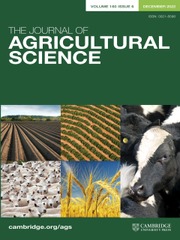Article contents
Study on the monitoring and classification of winter wheat freezing injury in spring based on 3S technology
Published online by Cambridge University Press: 08 March 2022
Abstract
Frequent freezing injury greatly influences winter wheat production; thus, effective prevention and a command of agricultural production are vital. The freezing injury monitoring method integrated with ‘3S’ (geographic information systems (GIS), global positioning system (GPS) and remote sensing (RS)) technology has an unparalleled advantage. Using HuanJing (HJ)-1A/1B satellite images of a winter wheat field in Shanxi Province, China plus a field survey, crop types and winter wheat planting area were identified through repeated visual interpretations of image information and spatial analyses conducted in GIS. Six vegetation indices were extracted from processed HJ-1A/1B satellite images to determine whether the winter wheat suffered from freezing injury and its degree of severity and recovery, using change vector analysis (CVA), the freeze injury representative vegetation index and the combination of the two methods, respectively. Accuracy of the freezing damage classification results was verified by determining the impact of freezing damage on yield and quantitative analysis. The CVA and the change of normalized difference vegetation index (ΔNDVI) monitoring results were different so a comprehensive analysis of the combination of CVA and ΔNDVI was performed. The area with serious freezing injury covered 0.9% of the total study area, followed by the area of no freezing injury (3.5%), moderate freezing injury (10.2%) and light freezing injury (85.4%). Of the moderate and serious freezing injury areas, 0.2% did not recover; 1.2% of the no freezing injury and light freezing injury areas showed optimal recovery, 15.6% of the light freezing injury and moderate freezing injury areas showed poor recovery, and the remaining areas exhibited general recovery.
Keywords
Information
- Type
- Climate Change and Agriculture Research Paper
- Information
- Copyright
- Copyright © The Author(s), 2022. Published by Cambridge University Press
References
- 4
- Cited by


